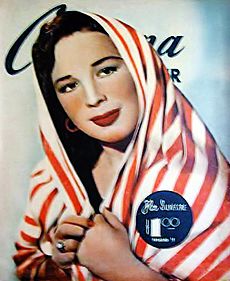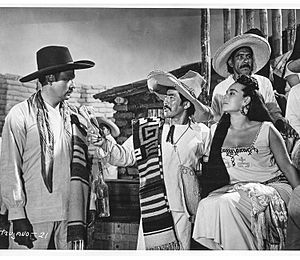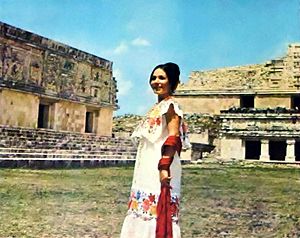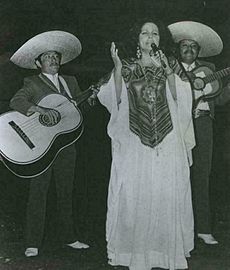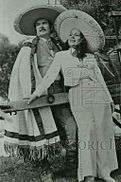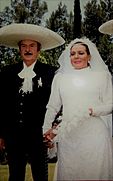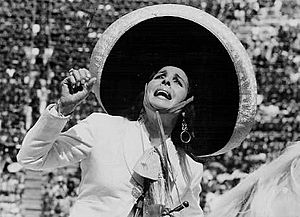Flor Silvestre facts for kids
Quick facts for kids
Flor Silvestre
|
|
|---|---|

Silvestre in Ánimas Trujano (1962)
|
|
| Born |
Guillermina Jiménez Chabolla
16 August 1930 |
| Died | 25 November 2020 (aged 90) Villanueva, Zacatecas, Mexico
|
| Occupation |
|
| Years active | 1943–2020 |
| Spouse(s) | Andrés Nieto Paco Malgesto
(m. 1953; div. 1958) |
| Children | Dalia Inés Francisco Rubiales Marcela Rubiales Antonio Aguilar, hijo Pepe Aguilar |
| Relatives | La Prieta Linda (sister) Mary Jiménez (sister) Majo Aguilar (granddaughter) Leonardo Aguilar (grandson) Ángela Aguilar (granddaughter) |
| Awards | Eduardo Arozamena Medal |
| Musical career | |
| Genres |
|
| Instruments | Vocals guitar |
| Labels |
|
| Associated acts |
|
| Signature | |
 |
|
Guillermina Jiménez Chabolla (born August 16, 1930 – died November 25, 2020), known as Flor Silvestre, was a famous Mexican singer and actress. She was one of the most successful performers of Mexican and Latin American music. Flor Silvestre was also a big star in classic Mexican films during the "Golden Age" of Mexican cinema. Her career lasted over 70 years. She performed on stage, in radio shows, recorded music, acted in films, appeared on TV, and even in comic books and rodeo shows.
Flor Silvestre was known for her beautiful voice and special singing style. People called her "La Sentimental" (The Sentimental One) and "La Voz Que Acaricia" (The Voice That Caresses). She sang many types of Mexican music, like ranchera, bolero, and huapango. She recorded more than 300 songs for three major record companies: Columbia, RCA Víctor, and Musart.
In 1945, she was called the "Alma de la Canción Ranchera" (Soul of Ranchera Song). By 1950, when she became a radio star, she was named the "Reina de la Canción Mexicana" (Queen of Mexican Song). She signed with Columbia Records in 1950 and recorded her first hit songs. These included "Imposible olvidarte", "Que Dios te perdone", and "Guadalajara". In 1957, she joined Musart Records. There, she had many best-selling songs like "Cielo rojo", "Renunciación", and "Mi destino fue quererte". Many of her songs appeared on music charts in Mexico. She also performed in musical rodeo shows with her husband, Antonio Aguilar.
Flor Silvestre acted in over seventy films between 1950 and 1990. She was a leading actress during the "golden age" of Mexican films. Her first acting role was in the film Primero soy mexicano (1950). She also acted with famous comedians like Cantinflas in El bolero de Raquel (1957). Director Ismael Rodríguez gave her important roles in La cucaracha (1959) and Ánimas Trujano (1962). Ánimas Trujano was even nominated for an Oscar. She was also the star of a comic book called La Llanera Vengadora. In 2013, she received a special award for her film career.
Flor Silvestre passed away on November 25, 2020, at her home in Villanueva, Zacatecas, Mexico.
Contents
- Life and Career
- Early Life and Childhood (1930–1943)
- First Steps in Music and Radio (1943–1949)
- Film Debut and First Recordings (1950–1952)
- Return to Films and TV Debut (1955–1957)
- Musart Records and Ánimas Trujano (1958–1963)
- Many Albums (1964–1969)
- Final Films and New Music Styles (1970–1989)
- Banda Albums and Tributes (1989–2020)
- Personal Life
- Death
- Awards and Honors
- Discography
- Selected Filmography
- Images for kids
- See also
Life and Career
Early Life and Childhood (1930–1943)
Flor Silvestre was born Guillermina Jiménez Chabolla on August 16, 1930. Her birthplace was Salamanca, Guanajuato, Mexico. She was the third of seven children. Her father, Jesús Jiménez Cervantes, was a butcher. Her mother was María de Jesús Chabolla Peña. Her younger sisters, Enriqueta and María de la Luz, also became singers.
Guillermina grew up in Salamanca and started singing very young. Her parents loved to sing and encouraged her talent. She enjoyed mariachi music from singers like Jorge Negrete and Lucha Reyes. She also sang popular songs from other styles like tango and bolero. Her love for singing and acting led her to perform in school plays and local festivals.
Her mother wanted the family to move to Mexico City. So, they sold their property in Salamanca. Her mother took the three youngest children to Mexico City. Guillermina and her older siblings stayed in Salamanca with their aunts, who were nuns. After finishing primary school, Guillermina joined her family in Mexico City. There, she took secretarial classes.
First Steps in Music and Radio (1943–1949)
Flor Silvestre began her singing career in 1943 when she was 13. She went with her father to a show by Mariachi Pulido at the Teatro del Pueblo in Mexico City. After the show, she bravely asked the director if she could sing. The mariachi group refused to play for an amateur. But the stage director, Carlos López Santillán, promised to let her sing the next week. He arranged for another mariachi band to play with her.
On her first day, she wore a traditional Mexican outfit her mother made. She sang three popular songs: "La canción mexicana", "Yo también soy mexicana", and "El herradero". Her performance was a huge success, and the audience cheered loudly.
Her next performance was in a play called La soldadera. She played a girl who sang a song written just for her. This play was also broadcast on Mexico's national radio station, XEFO. "La soldadera" was the first song she sang on the radio. The song's title, meaning "the female soldier," became her first stage name. However, another singer was already using it.
A journalist and radio announcer, Arturo Blancas, thought she looked "like a flower." He suggested she change her name to La Amapola (The Poppy). But this name was also taken. So, Blancas chose the title of a 1943 movie, Wild Flower, as her new stage name. That's how Guillermina Jiménez became Flor Silvestre, which means "wild flower."
With her new name, Flor Silvestre won first place in a contest on XEW, Mexico's most popular radio station. This led to a contract to sing in shows at the Teatro Colonial. This theater was very popular in the 1940s. Her performances there caught the eye of a showman. He hired her for his touring company.
Flor Silvestre toured with the company in northern Mexico. She was the opening act for the famous Argentine tango singer Hugo del Carril. Her family was having money problems, so she sang at banquets to earn more.
In December 1945, she performed in Guadalajara. She was introduced as "Flor Silvestre, the Soul of Ranchera Song." In 1946, a newspaper called her "Flor Silvestre, young XEW singer, who represents the feeling of our land within the ranchera song." From 1947 to 1949, Flor Silvestre toured Central and South America. She performed in the best nightclubs. Hugo del Carril introduced her to audiences in Argentina. The company even performed for the Mexican Air Force in Peru before returning to Mexico.
Film Debut and First Recordings (1950–1952)
When Flor Silvestre returned to Mexico in 1950, her manager got her a contract to perform at El Patio, a popular nightclub. Important people like Emilio Azcárraga, who owned the XEW radio station, and Gregorio Walerstein, a top film producer, saw her perform. They both hired her. Azcárraga gave her a radio show called Increíble pero cierto, which she also hosted. Walerstein signed her to a contract for five films.
Her radio show was a big hit, and her singing career took off.
Flor Silvestre made her first recordings in 1950 for Columbia Records in Mexico. She recorded at least twelve songs. These songs became her first hits. Some were "Imposible olvidarte" and "Guadalajara." She recorded them with mariachi bands. She also formed a singing duo called Las Flores with her sister, La Prieta Linda. They recorded two songs for Columbia.
In February 1950, she performed in a show about bullfighting called ¡A los toros!. It was written by Paco Malgesto, who later became her second husband. She sang Mexican songs related to bullfights in the show.
Flor Silvestre had sung in a film before, Te besaré en la boca (1949). But her first main role was in Primero soy mexicano (1950). She starred with Joaquín Pardavé and Luis Aguilar.
She later reunited with Luis Aguilar in El tigre enmascarado (1951). She then played the main female role in a film series: El lobo solitario, La justicia del lobo, and Vuelve el lobo (all 1952).
Return to Films and TV Debut (1955–1957)
In 1955, Flor Silvestre sang on the XEW radio show Su programa Calmex. Other famous singers also appeared on the show.
That same year, she acted in her first color film, La doncella de piedra. This was one of the first Mexican films made with CinemaScope. Flor Silvestre played Cantaralia Barroso, a mother in the story.
She also had a main role in a stage play called La hacienda de Carrillo. A theater critic wrote that she was "very beautiful and young... and also very tender as a vedette". That month, Flor Silvestre and other artists performed music for the film La virtud desnuda (1957).
Her first film with Antonio Aguilar, who would become her husband, was La huella del chacal. In the same year, she played a maid named Liliana in Rapto al sol, a color film shot in Nicaragua.
In 1957, RCA Victor released her first recording of "Cielo rojo." This song became one of her most famous. It was a big hit. On Mother's Day 1957, she made her television debut. She gave a successful performance in the TV play Secreto de familia. One of her well-known film roles was as Leonor, the mother of Cantinflas' godson, in the popular comedy El bolero de Raquel (1957).
Musart Records and Ánimas Trujano (1958–1963)
Flor Silvestre received top billing for the first time in Pueblo en armas (1959) and its sequel ¡Viva la soldadera! (1960). Both films were directed by Miguel Contreras Torres.
She had a supporting role with María Félix in Ismael Rodríguez's film La cucaracha (1959). This movie was about the Mexican Revolution. She also recorded songs like "Te he de querer" for the film's soundtrack album.
Flor Silvestre, her first album with Musart Records, came out around 1958. It included early hits like "El ramalazo" and "¡Qué bonito amor!".
In 1960, she starred with the comedy duo Viruta and Capulina in Dos locos en escena.
In 1961, she re-recorded "Cielo rojo" for Musart. This second version was also very popular. It was the first song on her second Musart album, Flor Silvestre con el Mariachi México. This album also had hits like "Pa' todo el año" and "Renunciación."
One of her most important roles was as Catalina in the film Ánimas Trujano (1962). This movie was nominated for an Oscar and won a Golden Globe. She starred with Toshirō Mifune. This was her second time working with director Ismael Rodríguez.
Many Albums (1964–1969)
In early 1964, she released her third Musart album, Flor Silvestre con el Mariachi México, vol. 2. It included hits like "Gracias" and "Perdí la partida." Her fourth Musart album, La sentimental (1964), had both ranchera and bolero songs. It was her first album without mariachi music. La sentimental reached number 9 on the Record World Latin American LP Hit Parade chart. Her song "Mi destino fue quererte" became one of her most famous. In December 1964, Cashbox magazine named her one of the top ten Mexican folk singers.
Her fifth Musart album, La acariciante voz de Flor Silvestre, came out in 1965. One of its songs, "Una limosna," topped the Record World Latin American Single Hit Parade chart. The album also included hits like "Gaviota traidora" and "El mar y la esperanza."
Celosa con Flor Silvestre y otros éxitos (1966) was her sixth album for Musart. It reached number 11 on the Record World Latin American LP Hit Parade. The main song, "Celosa," was a big hit on both Cashbox and Record World charts.
In 1967, she released two more albums and made her last film of the decade, El as de oros.
In 1968, she released Flor Silvestre, vol. 7 and Flor Silvestre, vol. 8. Flor Silvestre, vol. 7 included major hits like "Reconciliación" and "Tres días." Flor Silvestre, vol. 8 featured arrangements by famous musicians and included hits like "No vuelvo a amar."
Final Films and New Music Styles (1970–1989)
In 1970, she released her album Amor, siempre amor. It had new sounds with mariachi, piano, and steel guitar. One song, "La cruz de lo imposible," was the first work by songwriter Lupita Ramos, who wrote many more songs for Flor Silvestre. Another important song was "La mitad de mi orgullo" by José Alfredo Jiménez.
In the early 1970s, she recorded her first bolero album, Y las canciones de sus tríos favoritos. It had cover versions of popular boleros from the 1950s. Cashbox called it "a masterpiece for lovers of Latin boleros."
In 1972, she released three albums: Una gran intérprete y dos grandes compositores, La voz que acaricia, and Canciones con alma. She sang songs from her albums in films she made that year. Billboard magazine praised Canciones con alma as "a good solid LP overall of love ballads."
In 1973, she played one of Pancho Villa's lovers in La muerte de Pancho Villa. She also released her first norteño album, La onda norteña de Flor Silvestre. The album cover showed her as her character from the film. She also played Isabel Palma in the film Peregrina (1974), where she sang the bolero "Quisiera."
In 1974, she released Con todo mi amor a mi lindo Puerto Rico. This album honored two famous Puerto Rican songwriters. It included her hit "Cruz de olvido." The album came out when she appeared in the film Mi aventura en Puerto Rico.
She sang "La palma" in Simón Blanco (1975). She also played the main female roles in Don Herculano enamorado (1975), El moro de cumpas (1977), and Mi caballo el cantador (1979).
In 1978, she released Ahora sí va en serio, which had several songs written by Joan Sebastian. The main song was listed as a "Latin Single to Watch" by Cashbox.
In 1979, her song "Morir al lado de mi amor" was also listed as a "Latin Single to Watch" by Cashbox.
Banda Albums and Tributes (1989–2020)
In 1989, Flor Silvestre recorded banda music for the first time. She said she was scared to record with a "tambora" (a type of drum), but she loved it once she did.
Her last film was Triste recuerdo in 1990. In 1991, she recorded her first banda album, Flor Silvestre con tambora. It included a banda version of her hit song "Caricia y herida."
In 1994, she released Me regalo contigo. This album included a song dedicated to her marriage with Antonio Aguilar, "Para siempre juntos."
In 2001, she released her second banda album, also called Flor Silvestre con tambora. It had new versions of her 1960s hits like "Cariño santo" and "Mi destino fue quererte."
On December 21, 2010, she released her most recent album, Soledad: canto a mi amado y a su recuerdo. She dedicated this album to her late husband. It featured new songs she had never recorded before, like "Soledad" and "Luz de luna."
On March 9, 2015, a documentary about her, Flor Silvestre: su destino fue querer, premiered. The 24-minute film included interviews with Flor Silvestre, her five children, and other singers.
In 2016, she was featured on the song "Para morir iguales" on her son Antonio's album, Caballo viejo.
Personal Life
Flor Silvestre married her first husband, Andrés Nieto, in the 1940s. She had her first child, singer and dancer Dalia Inés Nieto, when she was 16.
Around 1953, Flor Silvestre married Francisco Rubiales Calvo, a radio announcer. He later became a famous TV presenter. They had two children, Francisco Rubiales and singer and actress Marcela Rubiales. They separated in 1958.
Flor Silvestre's third and last husband was the singer and actor Antonio Aguilar. He passed away in 2007. She considered him the love of her life. They first met in 1950 when he sang on her radio show. Their relationship began when they made the film El rayo de Sinaloa in 1957. They married in 1959 (or 1960). They had two sons, Antonio "Toño" Aguilar and José "Pepe" Aguilar, who also became singers and actors. Antonio Aguilar built a large home and ranch for her, called El Soyate, in Tayahua, Zacatecas.
On February 28, 2012, Flor Silvestre had surgery to remove half of her right lung due to cancer. She recovered well from the surgery.
Death
Flor Silvestre passed away on November 25, 2020. She died of natural causes at her home in "El Soyate" in Villanueva, Zacatecas, Mexico.
Awards and Honors
Flor Silvestre received many awards during her career. Her handprints are in the Plaza de las Estrellas, which is like the Hollywood Walk of Fame in Mexico.
- In 1966 and 1970, Musart Records gave her The Golden Clover award. This was for being one of their best-selling artists.
- In 1972, she won the Record World Award for Best Mexican Actress-Singer.
- In 2001, the National Association of Actors gave her the Eduardo Arozamena Medal. This was for her 50-year career.
- In 2008, she was the grand marshal of the Mexican Independence Parade in Los Angeles, California.
- In 2010, she received the Pedro Infante Medal for her "outstanding work and spreading Mexican music."
- In 2012, she received a "bull sculpture" award for her contribution to Mexican culture.
- In 2013, she received the Special Silver Goddess Award for her film career. Actor Ignacio López Tarso presented the award. He said she was "a great figure of Mexican cinema."
- In 2014, the Government of the State of Zacatecas honored her career. They gave her a special award at the Teatro Calderón.
- In 2015, she was honored in several cities while promoting her documentary, Flor Silvestre: Su destino fue querer.
Discography
Flor Silvestre made her first recordings in 1950 for Columbia Records in Mexico. She was backed by mariachi bands. Ten of these songs were later put on a greatest hits album called Flor Silvestre canta sus éxitos in 1964. This album was later re-released digitally.
She also recorded some songs for RCA Víctor in 1957. For this label, she recorded her first version of "Cielo rojo."
In 1957, Flor Silvestre signed with the Musart label. Her first recordings for Musart included songs for film soundtracks. In 1958, she released her first studio album for Musart, Flor Silvestre. Musart has over 300 of her recordings, many available digitally since 2008.
Hit Songs (Singles)
Some of her most popular hit songs include:
- "Imposible olvidarte" (1950)
- "Pobre corazón" (1950)
- "Guadalajara" (1950)
- "Adoro a mi tierra" (1950)
- "Cielo rojo" (1957)
- "Ay! el amor" (1959)
- "Mi destino fue quererte" (1964)
- "Gaviota traidora" (1964)
- "Celosa" (1966)
- "Perdámonos" (1967)
- "No vuelvo a amar" (1968)
- "Las noches las hago días" (1971)
- "La basurita" (1976)
Studio Albums
- Flor Silvestre (1959)
- Flor Silvestre con el Mariachi México (1963)
- La sentimental Flor Silvestre (1964)
- La acariciante voz de Flor Silvestre (1965)
- Celosa con Flor Silvestre y otros éxitos (1966)
- Boleros rancheros con la acariciante voz de Flor Silvestre (1967)
- Flor Silvestre, vol. 7 (1968)
- Amor, siempre amor (1970)
- Flor Silvestre y las canciones de sus tríos favoritos (1970)
- La voz que acaricia (1972)
- Canciones con alma (1972)
- La onda norteña (1973)
- Con todo mi amor a mi lindo Puerto Rico (1974)
- La basurita (1976)
- Ahora sí va en serio (1978)
- Flor Silvestre con tambora (1991)
- Me regalo contigo (1993)
- Soledad: canto a mi amado y a su recuerdo (2010)
Compilation Albums
- Flor Silvestre canta sus éxitos (1964)
- El disco de oro de Flor Silvestre (1977)
- 15 éxitos (1984)
- Mexicanísimo: Flor Silvestre (2015)
Selected Filmography
Flor Silvestre appeared in over seventy films. She was almost always the main star. Her films included many different types, like comedies, dramas, and westerns. Here are some of her classic Mexican films:
- Primero soy mexicano (1950)
- El tigre enmascarado (1951)
- El lobo solitario (1952)
- La huella del chacal (1956)
- El bolero de Raquel (1957)
- El jinete sin cabeza (1957)
- La Cucaracha (1959)
- Dos locos en escena (1960)
- Ánimas Trujano (1962)
- Tres muchachas de Jalisco (1964)
- El revólver sangriento (1964)
- Escuela para solteras (1965)
- El rifle implacable (1965)
- Caballo prieto azabache (1968)
- El as de oros (1968)
- Lauro Puñales (1969)
- El ojo de vidrio (1969)
Images for kids
See also
 In Spanish: Flor Silvestre para niños
In Spanish: Flor Silvestre para niños



